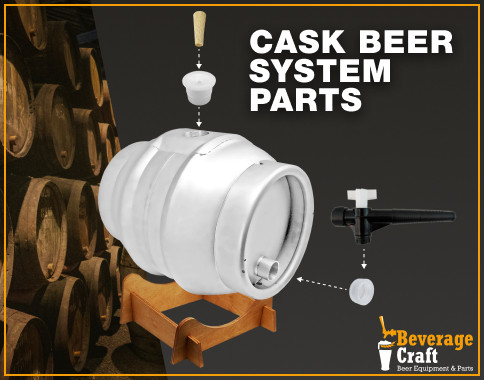Cask Beer System Parts, Components and Supplies
Posted by Ron on 26th Jul 2021
Beer in a cask (also known as cask ale or real ale) is different from kegged beer, mostly in terms of taste, storage, and dispensing. Let’s take a closer look at a cask beer system, see what makes it such a popular choice among beer aficionados, and whether a party keg can be considered as an alternative to a cask.
What Is the Difference Between Cask and Keg?
Being a fresh product by definition, cask ale requires conditioning when delivered to a pub cellar, and that’s arguably the main difference between keg and cask beer.
Unlike kegged beers which are usually pasteurized or sterile filtered (meaning they are ready to be dispensed right away), cask ale is fermented twice: first in the brewery and then once more in the cellar of a pub. Therefore, it has to be vented, tapped, and conditioned until it’s ready.
Another difference between a cask and a keg is that beer from the former is less fizzy since it doesn’t have added gas (although a light sparkle is still present). Unlike keg beer, cask ale should be dispensed and consumed within 3 days after it’s been exposed to air.
There’s also somewhat of a medium between cask vs keg, which is party kegs, particularly from Schaefer. Although they look and feel like traditional wooden barrels, they feature all the modern beer-dispensing capabilities and can be used for gravity-based dispensing.
Cask Ale System Parts and Components
Although a cask ale dispensing system is not all that complicated, it does differ from its keg counterpart. Mainly, because of the fact that beer in a cask ale cooling system has to go through a second fermentation process, which adds a few extra elements into the equation.

Let’s take a look at the key elements of a home cask beer system and see how they function together producing a uniquely fresh real ale.
- Cask
This is the original keg that’s been used to preserve and store beer for at least a thousand years. Although back in the day they were made of wood, modern casks are usually stainless steel.
The standard sizes of a cask for real ale are 9 gallons and 4.5 gallons. When used as part of a beer cask cooling system, casks feature two holes - one for the plug (2-inch hole, to regulate the conditioning process) and another one for the keystone (1-inch hole, to tap the beer).
- Shive
A small plastic plug that’s pounded into the cask before a spile can be driven in to allow the cask to breathe. - Spile
A small wooden peg nailed into the shive to control the carbonation level. There are two kinds of spiles - a hard spile (inserted into a keg after the end of the conditioning process) and a soft spile (replaces the hard one once a keg is tapped, to help release the excess CO2). - Keystone
A small plastic part that’s pounded into the top (outlet) of a cask keg before it’s tapped. - Spigot
Softly pounded into the keystone using a mallet, allowing you to tap the conditioned beer.
Since these four parts ( shive, spile, keystone, and spigot) are all required for proper cask ale dispensing, sometimes they come in a bundle that’s called a cask dispense kit.
If you feel confident enough and are looking to up your game, why not try a beer engine to pump directly from a cask - it’s a nice little device that will seriously upgrade your cask setup and turn it into a full-fledged cask beer pump system.
All these cask ale system parts can be easily purchased from Beverage Craft at a reasonable price. Feel free to browse our selection and let us know if you need something special for your beer cask cooling system.

